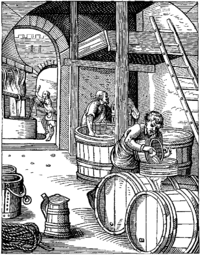
Photo from wikipedia
Disinfection by-products (DBPs) are associated with various adverse health effects. Diversiform advanced treatment processes have been applied for the control of DBPs, but DBPs can still be frequently detected in… Click to show full abstract
Disinfection by-products (DBPs) are associated with various adverse health effects. Diversiform advanced treatment processes have been applied for the control of DBPs, but DBPs can still be frequently detected in tap water. Tea-leaves can be made into popular beverage and is itself a porous bio-adsorbent. By simulating tea brewing process, this study evaluated the removal of DBPs from drinking water during the tea brewing process. Removal of four trihalomethanes (THMs) and four haloacetamides (HAMs) by different fermentation degree tea-leaves was investigated. Little DBPs were removed by unfermented and semi-fermented tea-leaves (i.e., Meitan turquoise bud and Dahongpao tea) with less than 5% removal of HAMs, whereas 40% HAMs can be removed by fermented tea (i.e., Jinjunmei tea and Shuixian tea). Tea soup is neutral and slightly acidic, so little DBP hydrolysis was observed under typical tea-leaf brewing process. DBPs were mainly removed by volatilization and adsorption during tea brewing. Removal difference caused by DBP volatilization is very small. The DBP removal difference of four kinds of tea-leaves may be caused by fermentation degree. The surface of unfermented Meitan turquoise bud had a smooth and regular morphology, whereas a rough, irregular, hollow and spongy surface of fermented tea (i.e., Jinjunmei and Shuixian tea) was observed. Generally, the higher the degree of tea fermentation, the more adsorption sites, and the more removal of DBPs. Finally, the model, which takes the DBP initial concentration, tea-leaf dose and brewing time into account, was established under the experimental conditions to predict the variation of DBP concentration during tea brewing, and suggestions for DBP removal were provided to reduce DBP exposure risk. The integrated toxic risk during tea brewing was also investigated, and about 30% integrated cytotoxicity and 26% genotoxicity was reduced during Jinjunmei and Shuixian tea-leaf brewing.
Journal Title: Water research
Year Published: 2020
Link to full text (if available)
Share on Social Media: Sign Up to like & get
recommendations!